Table of contents
- Comparison of mid-range all-rounders Middle class bikes from Yamaha, Kawasaki, Suzuki and Honda
- MOTORCYCLE scoring / test result
- Technical specifications
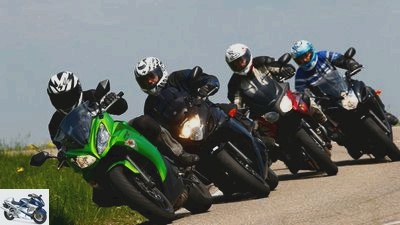
fact
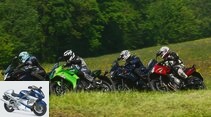
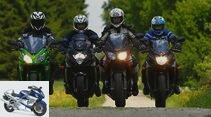
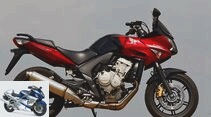
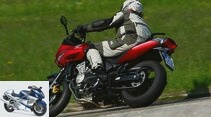
27 pictures
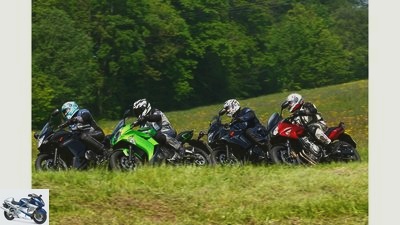
fact
1/27
Comparison of mid-range motorcycles from Yamaha XJ6 Diversion F, Kawasaki ER-6f, Suzuki GSX 650 F and Honda CBF 600 S.
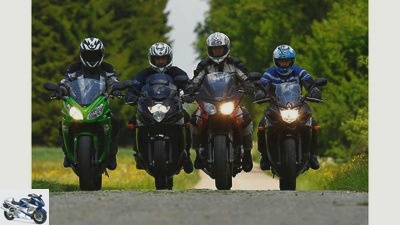
fact
2/27
No uniformity: completely individual faces. Only the fronts of the Suzuki and the more delicate Yamaha are similar.
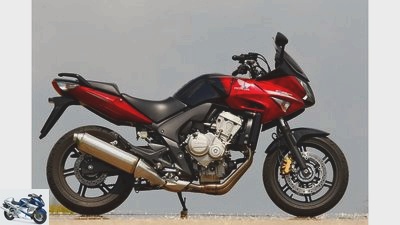
fact
3/27
Honda CBF 600 S..
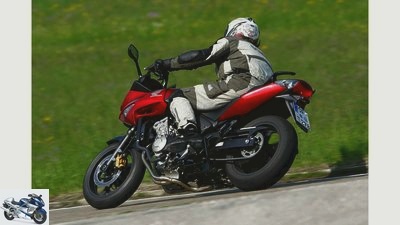
fact
4/27
Honda CBF 600 S: Well done: great handling meets great pillion passenger grab handles.
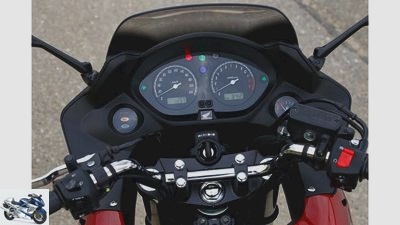
fact
5/27
Honda CBF 600 S: Control center: clearly arranged round instruments with thin needles. Only the fuel gauge (right) is a bit far out of view. Praiseworthy: the immobilizer, like on the Yamaha.
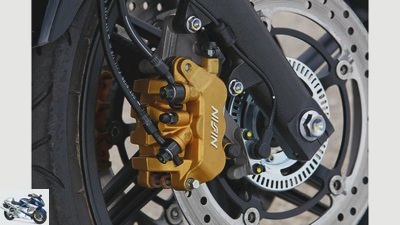
fact
6/27
Honda CBF 600 S: Combined braking: the middle piston of the right three-piston floating caliper is actuated by stepping on the pedal.

fact
7/27
Honda CBF 600 S: Hui und pfui: As on the Suzuki, the spring base of the fork is adjustable. But not the clutch lever, just like on the XJ.
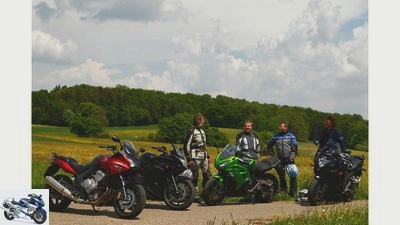
fact
8/27
Honda CBF 600 S, Yamaha XJ6 Diversion F, Kawasaki ER-6f and Suzuki GSX 650 F.

fact
9/27
Kawasaki ER-6f: Form and function: the strut on the right is easily accessible and emphasizes the line between the double tube frame and swing arm. New in 2012: two-part bench.
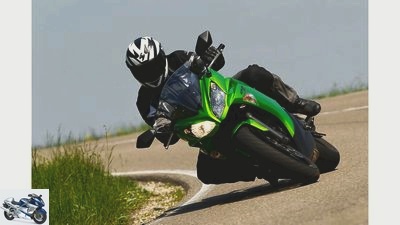
fact
10/27
Kawasaki ER-6f: The lightness of being: The handy Twin-Kawa sweeps fiery around the corner. Thanks to Motorrad-Holy from Schriesheim for the test copy.
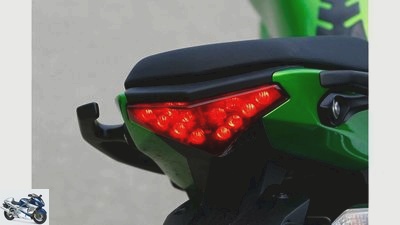
fact
11/27
Kawasaki ER-6f: Modern times: The exclusive LED taillights are durable and stylish.
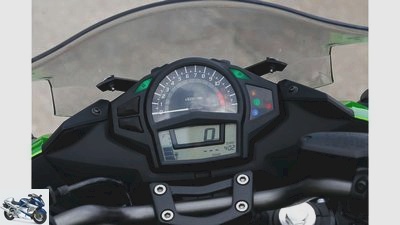
fact
12/27
Kawasaki ER-6f: Tidy: The cockpit of the 2012 version shines with a large rev counter and real on-board computer. However, the small LCD speedometer sits a bit low.
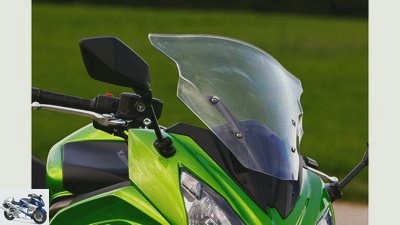
fact
13/27
Kawasaki ER-6f: Accomodating: The screen can be adjusted in three different positions using four screws, easier than with the two-way adjustable Honda windshield.
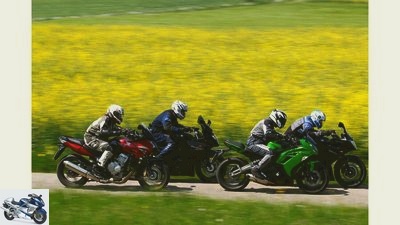
fact
14/27
Often underestimated: With 72 HP plus you can be damn fast when you need it.
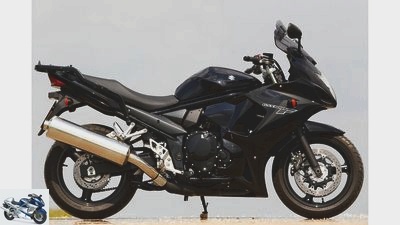
fact
15/27
Suzuki GSX 650 F.
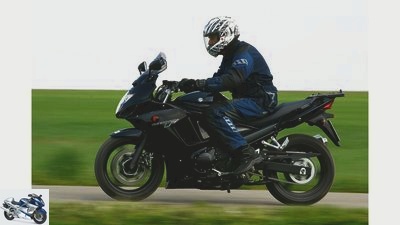
fact
16/27
Suzuki GSX 650 F: First choice for tall drivers: the 247 kilogram 650cc Suzuki. However, the knees hit the side panel.

fact
17/27
Suzuki GSX 650 F: Dominant rev counter with a beautiful white background. The only gear indicator in the quartet is exclusive and useful – the shift light is not required.
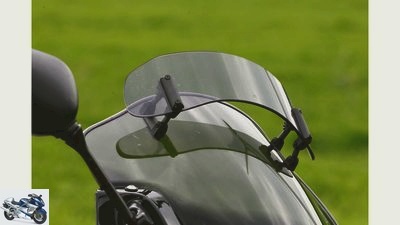
fact
18/27
Suzuki GSX 650 F: Small but mighty: the adjustable attachment (“Vario touring screen” for 120 euros) can effectively divert the wind power depending on requirements.
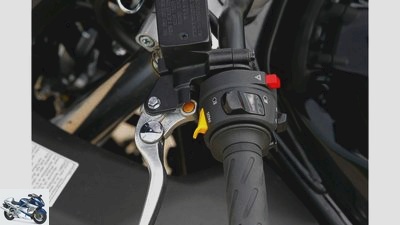
fact
19/27
Suzuki GSX 650 F: The joys of everyday life: As with the Kawasaki, the clutch lever can be adjusted within reach; All four have a hazard warning function on board.
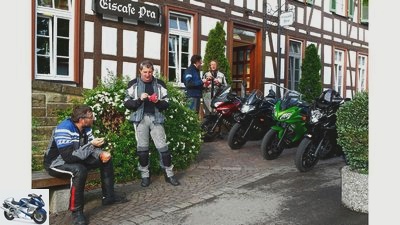
fact
20/27
Faithful everyday companions: whether for work, the weekend or the ice cream parlor – four for everything.
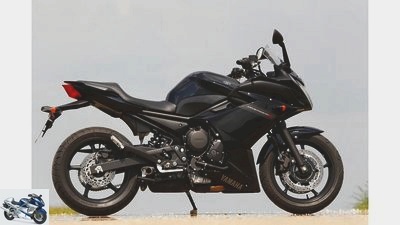
fact
21/27
Yamaha XJ6 Diversion F..
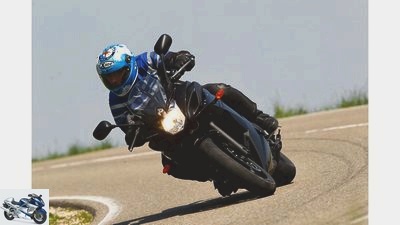
fact
22/27
Yamaha XJ6 Diversion F: The slim XJ is very light-footed and easy to move.

fact
23/27
Yamaha XJ6 Diversion F: Active driving, active watching: the tachometer has a lot to do with the short-geared four-cylinder. The displays and indicator lights are a bit small.
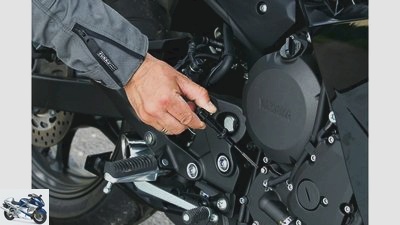
fact
24/27
Yamaha XJ6 Diversion Q: You have to like it: In contrast to the three other engines, the oil is checked using a dipstick instead of sight glasses.

fact
25/27
Yamaha XJ6 Diversion F: Mediocre – The manifolds are made of stainless steel, the exhaust manifold is made of painted sheet steel.
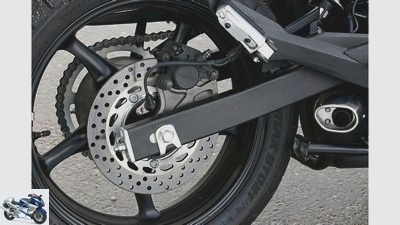
fact
26/27
Yamaha XJ6 Diversion F: simple chain tensioner.
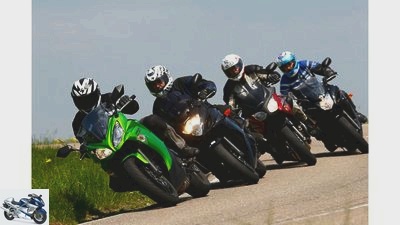
fact
27/27
Kawasaki ER-6f, Suzuki GSX 650 F, Honda CBF 600 S and Yamaha XJ6 Diversion F.
motorcycles
Middle class bikes from Yamaha, Kawasaki, Suzuki and Honda
Comparison of mid-range all-rounders
Middle class bikes from Yamaha, Kawasaki, Suzuki and Honda
A heavily renovated two-cylinder is facing three well-established four-cylinder models: In the affordable, price-conscious middle class, the third generation of the Kawasaki ER-6f meets the direct Japanese competitors with twice as many cylinders. What the whole quartet has in common: They are motorcycles that are always there for you, not overwhelming, but offer a hell of a lot.
Thomas Schmieder
06/21/2012
Not much going on today at the “Lowensteiner Platte” motorcycle meeting place near Heilbronn, at noon during the week. Still a shame. Simply no audience around the completely revised third generation of the Kawasaki Consider ER-6f. At first glance, the 650er looks like a little sister to the Kawasaki Z 1000 SX in the green dress and the more strikingly designed full fairing. Only with half the number of cylinders and almost two thirds of the displacement. Here and now, the two-cylinder compares with the more or less interconnected four-cylinder models from Honda, Suzuki and Yamaha.
In this quartet, the Honda is the only machine that keeps its shiny metallic engine and stainless steel manifolds sparkling in the sun – without a plastic diaper left and right. With seat heights that can be adjusted in three ways and are easy to control, the CBF models reach a wide audience. The Suzuki GSX 650 F represents the fully disguised variant of the 650 bandit, but shouldn’t be called that. And the ya-maha XJ6 Diversion quotes the tradition of the highly successful XJ model family from the 80s and 90s with 550 to 900 cubic centimeters.
What do the quartet have in common? All four machines are reliable, fully suitable for everyday use and easy to use. They have between 600 and 650 cubic meters, produce a healthy 72 to a good 80 hp on the test bench and cost between 7,000 and 8,000 euros. An attractive, promising mix. Which, however, is hardly enough to stretch your neck and be admired. Such machines are generally seen as something for beginners (completely rightly thanks to ABS, moderate weight and 34 hp options) and women (not entirely unjustifiably thanks to the rather narrow cut). But there are also full-blown motorcycles with acceptable chassis and powerful engines that do as much today as the “motorcycle of the century” Honda CB 750 Four and Kawasaki Z1.
Yes, the driving dynamics are very promising with a mass of only around 220 kilograms. Only the approximately five quintals heavy Suzuki falls out of the ordinary in terms of weight. But even it has a better power-to-weight ratio than any sports car. When it comes to cars, the Audi A4, Mercedes C-Class and BMW Dreier are recognized figures in the lower middle class. Corresponding motorcycles are more likely to be ridiculed as if middle class were equal to average. Why this different rating?
What is so wrong with the rolling pedestal going along with everything, everyday life and home trips, weekend tours and driving from A to B? Everything is possible, nothing is neccesary. Except that this compact class doesn’t prompt you to say goodbye to your driver’s license too quickly. Hmmmh, disdain for the middle class seems like something difficult psychological. Well then, go ahead, without any prejudices or exaggerated performance mania. Straight through!
Buy complete article

Comparison of mid-range all-rounders
Middle class bikes from Yamaha, Kawasaki, Suzuki and Honda
14 pages) as PDF
€ 2.00
Buy now
The 2012 model of the Kawasaki ER-6f shows familiar basic shapes, just sharper, more valuable. With the exception of the 72 hp engine, none of the components came from the predecessor. Frame, swing arm, tank, instruments, handlebars, two-part seats – all new. Even the exhaust, rear fairing and side covers have been modified. A sleek third generation of the “f” presented in 2006. Its two-cylinder in-line engine emphasizes Kawasaki traditions such as the Z 440, KLE and GPZ 500 or the extremely handy ER-5. Only the bulky model name ER-6f omits 50 cubic centimeters. “ER” means “Essential” or “Easy Riding” – the essential, simple thing about riding. This is exactly what the Honda CBF 600 S, Suzuki GSX 650 F and Yamaha XJ6 Diversion F on the flags.
“Is the engine running yet?” Kawa driver Gabriel points to the Yamaha, on which the author is just pressing the button. The 600 four-cylinder whispers very gently from the black-painted muffler installed under the engine. In its earlier life, the four-cylinder – unthrottled – drove an earlier R6 generation. The CBF four-cylinder grumbles a little deeper, duller from the stainless steel exhaust system. This engine is also an ex-super sports car that has been extensively redesigned to 78 hp for everyday use, comes from the current CBR 600 R..
In terms of sound, the Suzuki GSX 650 F with its huge stovepipe silencer is in between. In Titanic times, a ship’s chimney would have been welded from so much material. In addition, the cheapest black painted manifold of the GSX earns little enthusiasm. The Suzuki has a shot glass more displacement, relies on the engine, which was exclusively developed for Suzuki’s bandits and presented in 2007. It carries the chain to the camshaft drive in the middle, between cylinders two and three. This results in symmetrical motor sides on the left and right, unlike the three other motors in which the timing chain slot is on the right.
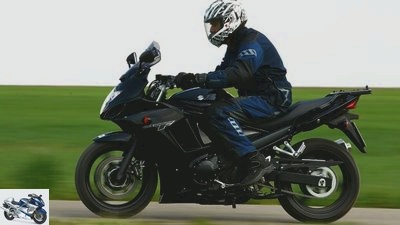
fact
Suzuki GSX 650 F: First choice for tall drivers: the 247 kilogram 650cc Suzuki. However, the knees hit the side panel.
Double overhead camshafts are good form with the quartet. Good tone? The Kawasaki ER-6f cannot be asked for long. The two-cylinder wakes up with a fine twin-bollern, sounds more robust and subjectively bubbles a little louder than the softer four-cylinder. Real motorcycle sound that flows out of the exhaust system made entirely of stainless steel.
In 2012, the thick silencer under the engine on the front right was given a funnel-shaped extra volume and new catalytic converters inside. All this, as well as changed software and a new connecting pipe between the jagged manifolds, should further increase the torque at medium speeds. However, this cannot be confirmed by the incorruptible MOTORRAD dynamometer. On the contrary, the earlier ER-6 had even more flavor to offer. The 2012 model of the 650 actually lost some torque across the entire engine speed range. The maximum torque fell from a measured 66 to 64 Newton meters.
In practice, however, that doesn’t matter. Because the performance curve is still fuller up to 9000 tours than that of the three four-cylinder units, including the even larger-capacity Suzuki. Two large pistons with a diameter of 83 millimeters clock the Kawasaki its heartbeat. They run in opposite directions, offset by 180 degrees. The entire hardware including the six-speed cassette transmission remained untouched. Kawasaki combined the narrowest and therefore handling-enhancing crankshaft of the quartet with a fairly high flywheel. Even at 2000 rpm, this twin runs really smoothly without hacking the chain.
Balance shaft or not, the Kawa-Twin vibrates and stomps the hardest. On the positive side, the ER-6f’s in-line engine pulsates most lively, most emotionally. However, it turns less stormy than the brilliant 90-degree V2 of a Suzuki Gladius. Wait a minute, Gladius? In the past, Suzuki had the exciting SV 650 – each in a naked and a half-disguised S version in its range. But – a Gladius can only be found unveiled, as the designer created it.
So it remains on the in-line four-cylinder to hold up the flag for Suzuki in the clad middle class – with half-shell in the Bandit 650 S, fully clad here in the GSX 650 F. Both have practically the same chassis and the same dimensions as the large 1250. This is called a cost-saving “common parts strategy”. A VW Golf is also available with different engines. But this approach also drives the weight up – to a whopping 247 kilograms, still without the extra costly main stand. And why the GSX, dubbed the “Sport Tourer”, has to do without the adjustable seat height and the much finer stainless steel elbows of the Bandit siblings remains a mystery.
Likewise, why the four-cylinder with the thick cooling fins has to vibrate so annoyingly. A fine tingling sensation makes the handles, tank sides and footrests tremble, despite the thick counterweights under the latter. Especially at the preferred medium speeds, for example at the recommended motorway speed 130, the hands become numb in the long run. The Yamaha shows how it can be done better: it doesn’t vibrate at all up to 6000 tours. This makes up for how super-elastic the Suzuki engine runs, how lazy it can be moved. It drives completely smoothly even at 35 km / h in sixth gear. Good thing, because the clutch requires the greatest manual force and the transmission shifts the hardest of all.
The cartilaginous gearshift feel requires emphasis when changing gear. The only gear indicator in the comparison is practical. You always know what the gearbox has been doing. The Suzuki shows yet another peculiarity: After rolling phases with the throttle closed (“push mode”), it jumps quite hard on the gas again. This is exactly what their double throttle valves are supposed to prevent: one is operated by the driver, the second is adjusted by the on-board computer in order to optimize the flow depending on the load condition, engine speed and opening angle. So much for the theory. In practice, the hard throttle response at the apex of bends that cannot be seen can be quite irritating. After all, we are now screwing our way through the wonderfully green Swabian-Franconian Forest.
It smells of wild garlic carpets from the beech forests. Finally a picture-perfect spring day! The almost weightless handling of the Kawasaki ER-6f fits in with this. All four machines benefit from narrow 160 mm rear tires and are pampered with great maneuverability. But none of the four all-rounders is as light-footed as the Kawasaki, which weighs 213 kilograms. With her wide handlebars she throws herself into the corners with a lot of verve. Because of cute! And their tires, Dunlop Roadsmart II, spoil you with the best grip in this field. That makes a good feeling. Just like the narrow waist when standing: a single, thin support made of rectangular tubing sits between the front and rear frames of the 2012 ER-6.
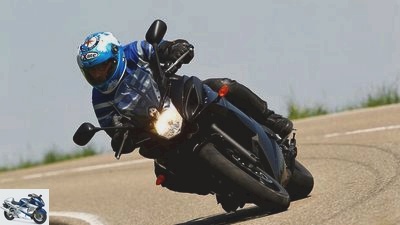
fact
Yamaha XJ6 Diversion F: The slim XJ is very light-footed and easy to move.
However, the knee angle is the sharpest of all four, a tribute to the high-placed notches and immense lean angle. Because the handlebars are cranked far back, tall riders don’t get along well with the Kawasaki. The exciting ER-6f is the only motorcycle that shows the directly hinged shock absorber. Only the Suzuki has a progressive deflection. A little drier, less sensitive than the other three, the rear suspension of the ER-6f responds to mogul slopes. In the new model, softer, longer springs at the front and rear meet adapted damping.
Positive: As usual, the suspension strut, which is off-center to the right as an eye-catcher, is easily accessible for adjusting the preload. The chassis of the Kawasaki does not allow more adjustment options. The same goes for the Yamaha XJ6, which also has simple chain tensioners. In contrast, the new double tube swing arm of the Kawasaki has fine chain tensioners with elegant, easily adjustable sliding pieces. However, the bread bin silencer under the row twin does not allow a main stand. So chain spraying becomes a chore. Honda and Yamaha carry a main stand as standard, with the Suzuki it costs 125 euros extra, see equipment table. But the rebound can only be adjusted on the shock absorber.
With the low-torque CBF, as with the GSX, the spring base of the 41-millimeter telescopic fork can also be adjusted. But even in the basic setting, the balance, the fine balance of the CBF chassis inspires. For this class, the 600 is almost steadfastly on its way. The Honda drives almost by itself and is very easy to circle around potholes and zebra crossings. Their simple but effectively coordinated spring elements fish a lot from pitted asphalt surfaces. “Good response behavior” means something like that. That creates trust, especially with less experienced pilots. When it comes to driving, Honda’s supposedly honest man is completely convincing.
The best brakes on these four Japan machines play a major role in this. The two three-piston floating calipers at the front bite the 296 brake discs in an easy-to-dose manner. The rest of the trio are satisfied with double-piston floating calipers, this also applies to the Kawasaki with their chic, corrugated wave brake discs. CBF has something else exclusive: a composite braking system. When you step on the pedal, the middle brake piston at the front right brakes. And the transmission clicks easily, the engine is an inconspicuous companion in the best sense of the word. All in all, this Honda embodies a neat, unagitated seriousness typical of the brand.
So exactly what made Yamaha’s XJ range so special. Today there is only one displacement variant, the same 600 in three versions: naked, half-disguised as “Diversion” or, as shown here, fully disguised as Diversion F (“Full Fairing”). The 600 Yama-ha has even smaller pistons (should you say “little flask”?) Than the Honda – with a diameter of 65.5 instead of 67 millimeters. So your motor has more stroke and is not quite as short-stroke as the CBF. Amazingly, the Yamaha still has to be twirled more, the less short-stroke design does not bring more torque.
The briefly translated XJ6 requires a hard-working gearshift foot, one is constantly looking for the missing seventh gear. No problem, because the clutch is very easy to pull, the motor turns diligently like a sewing machine up to five-digit ranges. And in the sixth, the XJ goes from 60 to 140 km / h even faster than the Kawasaki ER-6f. Only then does the lighter Kawa take the lead. The small, lively Yamaha four-cylinder almost succeeds in squaring the circle.
But not their chassis. The XJ drives beautifully simple and neutral, well predictable. On good roads. But their comfort-oriented coordination with soft springs and lax damping only packs in wadding. On the one hand, the XJ6 also moves a little less precisely than the CBF and ER-6. On the other hand, the Yamaha chassis reaches its limits early and has too few reserves. The chassis wobbles and swings through the curves on lousy terrain, for example along the golden yellow blooming rapeseed fields.
Even on flat asphalt, the Yamaha reacts sensitively to a pillion passenger, the underdamped shock absorber does not handle the load properly. Whether that’s why the back seat is so small and the payload (179 kilograms so low? And the grab handles for the pillion passenger are so difficult to grip? So that you don’t get embarrassed …) A passenger sits a little better on the Kawasaki. But with one of these, the ER-6f loses its otherwise great accuracy.
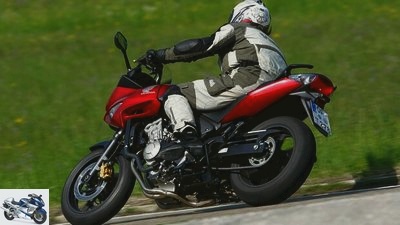
fact
Honda CBF 600 S: Well done: great handling meets great pillion passenger grab handles.
Both the Suzuki pillion and the driver are plagued by annoying vibrations in the seat. The driver intuitively feels the excess pounds of the GSX when he mounts and every time he turns. The Suzuki is heavy and feels that way. On the positive side: she looks very grown up. It is best to sit in front and behind on the Honda: The knee angle for the crew is open, the seat is comfortable and the posture is upright. In addition, the pillion grab handles are large and easy to grip. Even with a full load, the Honda remains very stable, even when braking hard.
In the evening on the empty autobahn, all four candidates show really good directional stability when cracking the 200 mark. Active, front-wheel-oriented because it leans slightly forward, it sits on the GSX and XJ6. The Suzuki offers great wind protection. On the projecting pane of the test machine, there is an adjustable attachment that costs 120 euros. This “vario touring windshield” conducts the wind flow effectively, but sometimes a little loudly around the head and shoulders. With Honda and Yamaha, the latter are always free in the wind if you don’t duck down on the track at some point. When fully raised, the ER-6 windshield spoils you with good protection.
Kawasaki’s 650s were already successful before they were redesigned: Together with the uncovered, 500 euro cheaper sister ER-6n, Kawasaki has sold more than 60,000 copies of the machines built in Thailand in Europe. In Germany they are Kawasaki’s best-selling model range; With 1893 sales in 2011, the 650s were in third place among German motorcycle sales.

fact
Kawasaki ER-6f: The lightness of being: The handy Twin-Kawa sweeps fiery around the corner. Thanks to Motorrad-Holy from Schriesheim for the test copy.
The CBF 600 models are an evergreen, were Honda’s bestsellers in Germany in 2011 – with 1319 new sales. The naked and half-disguised S version are 300 euros apart, 7340 to 7640 euros. The CBF models are built in Atessa, Italy. And the XJ6 was the best-selling Yamaha in Germany with 1737 units last year. The cost of the three versions including ABS: 6995, 7295 or in our case 7795 euros – the steep surcharge for the lower fairing parts makes the XJ6 Diversion F the most expensive motorcycle in this comparison.
Only the Suzuki fell a little in favor of buyers recently. In the past, the 600 and 650 bandits always landed at the top of the sales statistics, those days are over. “Bigger than you think” is Suzuki’s slogan for the GSX 650 F.
Well, in a class that not only makes seasoned drivers happy but also (re) beginners, such an orientation is more of a disadvantage, not only hampers maneuverability when standing still. The Honda CBF is heading towards a superior test victory with a respectable point advantage. Behind them, the three other test machines are delivering an extremely close neck-and-neck race. When allocating places, every single point counts, so the small differences have a special effect.
MOTORCYCLE scoring / test result
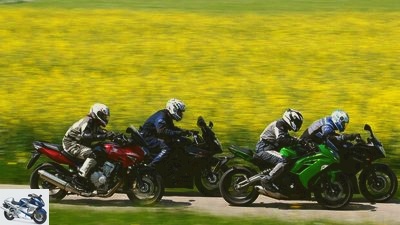
fact
Often underestimated: With 72 HP plus you can be damn fast when you need it.
engine
Aha effect. In the engine chapter, the 600s are ahead of the 650s – and the XJ6 right at the front. How can that be? Well, the Yamaha is particularly sensitive to the gas, runs up to 6000 rpm without any vibrations and has a clutch that is easy to pull and easy to adjust. The powerful Kawasaki and even more so the Suzuki suffer a bit from bony, stiff switch boxes.
Winner engine: Yamaha
landing gear
The CBF clearly dominates. It is wonderfully stable, even with a passenger, and extremely precise in steering. The fork and shock absorber of the Honda are particularly well coordinated. The ER-6f offers even greater handiness and freedom from inclination. But the Kawasaki, together with the soft, particularly comfortable XJ6, has the poorest possible adjustment options on the chassis – only the rear spring base.
Chassis winner: Honda
everyday
Another advantage of Honda. It combines the best seats for the driver and pillion with a royal range of up to 465 kilometers. And also offers great feedback and ease of use. The moderately processed GSX scores with the highest payload and also a good place for passengers. With the ER-6f, the driver’s knee angle is a bit acute, with the XJ6 it is difficult to transport luggage.
Winner everyday: Honda
security
Good brakes are a Honda domain. This is also the case with CBF. Only it combines rear and front wheel stoppers, it anchors strongly and is best metered. Just behind is the Kawasaki, which benefited from the new ABS control in 2012.
Safety winner: Honda
costs
Stalemate. The XJ6 has 10,000 service intervals, the ER-6f has the lowest fuel consumption. Only Suzuki offers a mobility guarantee.
Winner costs: Kawasaki / Yamaha
Price-performance
CBF offers the greatest quality at a moderate price. Then comes the kawa.
Price-performance winner: Honda
| maximum number of points | Honda | Kawasaki | Suzuki | Yamaha | Overall rating | 1000 | 645 | 622 | 620 | 621 | placement | 1. | 2. | 4th. | 3. | Price-performance note | 1.0 | 1.1 | 1.4 | 1.5 | 1.5 |
MOTORCYCLE test results
1. Honda CBF 600 S..
Good-naturedness has a name: CBF. The bottom line is that it drives clearly the best. The 600 is typically Honda, everything fits together, suits the driver, right down to the variable seat height. CBF makes it fascinatingly easy. Compact and great!
2. Kawasaki ER-6f.
The lively, lush green Kawa forms the splash of color in this quartet. Your economical two-cylinder sounds more robust, runs full of character, vibrates more than the four-cylinder. The 2012 model has been significantly upgraded in terms of equipment and chassis – almost at no extra charge.
3. Yamaha XJ6 Diversion F.
The nimble, neat 600 series is particularly speed-hungry and fast. Your ostensibly comfortable chassis suffers a little from underdamped suspension elements, especially with a pillion passenger or on poor roads there is a lack of reserves.
4. Suzuki GSX 650 F.
Does a lot help a lot? Well, in terms of displacement and power, the “fully disguised Bandit” actually offers a lot of motorcycle for little money. But unfortunately also quite a lot of pounds. This has an effect on the driving dynamics and scares off beginners in particular.
Technical specifications
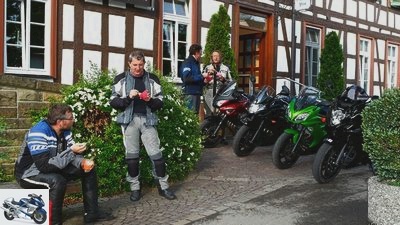
fact
Faithful everyday companions: whether for work, the weekend or the ice cream parlor – four for everything.
| Honda | Kawasaki | engine |
| design type | Four-cylinder, four-stroke in-line engine | Two-cylinder four-stroke in-line engine | Injection / intake cross-section | Ø 32 mm | Ø 38 mm |
| coupling | Multi-disc oil bath clutch | Multi-disc oil bath clutch | Bore x stroke | 67.0 x 42.5 mm | 83.0 x 60.0 mm |
| Displacement | 599 cm3 | 649 cm3 | compression | 11.6: 1 | 10.8: 1 |
| perfomance | 57.0 kW (78 hp) at 10500 rpm | 53.0 kW (72 hp) at 8500 rpm | Torque | 59 Nm at 8250 rpm | 66 Nm at 7000 rpm |
| landing gear | frame | Central tubular frame made of aluminum | Bridge frame made of steel |
| fork | Telescopic fork, Ø 41 mm | Telescopic fork, Ø 41 mm | Brakes front / rear | Ø 296 mm / Ø 240 mm | Ø 300 mm / Ø 220 mm |
| Assistance systems | Partly integral braking system with ABS | SECTION | bikes | 3.50 x 17; 5.00 x 17 | 3.50 x 17; 4.50 x 17 |
| tire | 120/70 ZR 17; 160/60 ZR 17 | 120/70 ZR 17; 160/60 ZR 17 | Tires | Bridgestone BT 021, front “N”, rear “W” | Dunlop Roadsmart II “J” |
| mass and weight | wheelbase | 1490 mm | 1410 mm |
| Steering head angle | 65.0 degrees | 65.0 degrees | trailing | 110 mm | 110 mm |
| Front / rear suspension travel | 120/128 mm | 125/130 mm | Seat height ** | 770-790 mm | 800 mm |
| Weight with full tank ** | 226 kg | 213 kg | Payload ** | 191 kg | 198 kg |
| Tank capacity | 20.0 liters | 16.0 liters | Service intervals | 6000 km | 6000 km |
| price | 7640 euros | 7495 euros | extra costs | 265 euros | 170 euros |
| MOTORCYCLE measurements | Top speed * | 213 km / h | 205 km / h |
| acceleration | 0-100 km / h | 4.0 sec | 4.0 sec |
| 0-140 km / h | 7.1 sec | 7.6 sec | 0-200 km / h | 21.1 sec | 24.0 sec |
| Draft | 60-100 km / h | 5.6 sec | 4.8 sec |
| 100-140 km / h | 5.7 sec | 5.4 sec | 140-180 km / h | 7.9 sec | 6.6 sec |
| Consumption highway | 4.3 liters / normal | 3.9 liters / normal | Reach country road | 465 km | 410 km |
| Suzuki | Yamaha | engine |
| design type | Four-cylinder, four-stroke in-line engine | Four-cylinder, four-stroke in-line engine | Injection / intake cross-section | Ø 36 mm | Ø 32 mm |
| coupling | Multi-disc oil bath clutch | Multi-disc oil bath clutch | Bore x stroke | 65.5 x 48.7 mm | 65.5 x 44.5 mm |
| Displacement | 656 cm3 | 600 cm3 | compression | 11.5: 1 | 12.2: 1 |
| perfomance | 63.0 kW (86 hp) at 10500 rpm | 57.0 kW (78 hp) at 10,000 rpm | Torque | 62 Nm at 8900 rpm | 60 Nm at 8500 rpm |
| landing gear | frame | Double loop frame made of steel | Bridge frame made of steel |
| fork | Telescopic fork, Ø 41 mm | Telescopic fork, Ø 41 mm | Brakes front / rear | Ø 310 mm / Ø 240 mm | Ø 298 mm / Ø 245 mm |
| Assistance systems | SECTION | SECTION | bikes | 3.50 x 17; 5.00 x 17 | 3.50 x 17; 4.50 x 17 |
| tire | 120/70 ZR 17; 160/60 ZR 17 | 120/70 ZR 17; 160/60 ZR 17 | Tires | Bridgestone front BT 011 “N”, rear BT 020 “G” | Bridgestone BT 021 “G” |
| mass and weight | wheelbase | 1470 mm | 1440 mm |
| Steering head angle | 64.0 degrees | 64.0 degrees | trailing | 108 mm | 104 mm |
| Front / rear suspension travel | 130/128 mm | 130/130 mm | Seat height ** | 800 mm | 800 mm |
| Weight with full tank ** | 247 kg | 221 kg | Payload ** | 208 kg | 179 kg |
| Tank capacity | 19.0 liters | 17.0 liters | Service intervals | 6000 km | 10000 km |
| price | 7790 euros *** | 7795 euros | extra costs | 135 euros | 170 euros |
| MOTORCYCLE measurements | Top speed * | 205 km / h | 205 km / h |
| acceleration | 0-100 km / h | 4.2 sec | 3.9 sec |
| 0-140 km / h | 7.4 sec | 7.3 sec | 0-200 km / h | 21.2 sec | 26.7 sec |
| Draft | 60-100 km / h | 5.0 sec | 4.7 sec |
| 100-140 km / h | 5.6 sec | 5.2 sec | 140-180 km / h | 7.4 sec | 7.4 sec |
| Consumption highway | 4.6 liters / normal | 4.2 liters / normal | Reach country road | 413 km | 405 km |
* Manufacturer information; ** MOTORCYCLE measurements; ** plus main stand (124.95 euros) and vario touring screen (119.95 euros)
Related articles
-
Big bikes from Honda, Suzuki, Kawasaki and Yamaha
archive counselor Used purchase Big bikes from Honda, Suzuki, Kawasaki and Yamaha Buying advice: big bikes The big bike generation from 1984 Content of…
-
Honda CBF 600 S, Suzuki Bandit 650 S, Yamaha FZ6 Fazer
Rossen Gargolov 17th pictures Suzuki 1/17 Suzuki 2/17 Suzuki 3/17 Suzuki 4/17 Suzuki 5/17 Suzuki 6/17 Suzuki 7/17 Suzuki 8/17 Suzuki 9/17 Suzuki 10/17…
-
Honda CBF 600 S, Suzuki Bandit 650 S, Kawasaki ER-6f, Suzuki SV 650 S
Artist 18th pictures Honda 1/18 Honda 2/18 Honda 3/18 Honda 4/18 Honda 5/18 Honda 6/18 Honda 7/18 Honda 8/18 Honda 9/18 Honda 10/18 Honda 11/18 Honda…
-
Comparison test: Honda Hornet, Kawasaki Z 750, Suzuki GSR 600
Jahn motorcycles Comparison test: Honda Hornet, Kawasaki Z 750, Suzuki GSR 600 Comparison test: Honda Hornet, Kawasaki Z 750, Suzuki GSR 600 ABS shooters…
-
Bargains from Honda, Kawasaki, KTM and Suzuki
jkuenstle.de motorcycles Bargains from Honda, Kawasaki, KTM and Suzuki Honda CBR 250 R, Kawasaki Ninja 300 R, KTM 200 Duke, Suzuki Inazuma 250 Four…
-
Honda Fireblade, Kawasaki Ninja ZX-10R, Suzuki GSX-R 1000, Yamaha YZF-R1
fact 28 pictures Honda 1/28 Honda 2/28 Honda 3/28 Honda 4/28 Honda 5/28 Honda 6/28 Honda 7/28 Honda 8/28 Honda 9/28 Honda 10/28 Honda 11/28 Honda 12/28…
-
250 class: Honda, Kawasaki, KTM and Suzuki
www.jkuenstle.de motorcycles 250 class: Honda, Kawasaki, KTM and Suzuki 250/300 motorcycles at a glance The entry-level class has made itself chic Small…
-
Comparison test Kawasaki Versys 650, Suzuki V-Strom 650 and Yamaha Tracer 700
www.factstudio.de 27 pictures www.factstudio.de 1/27 Crossover comparison test with the Kawasaki Versys 650, Suzuki V-Strom 650 and Yamaha Tracer 700….
-
Comparison test: Honda CBF 1000 Silverline, Suzuki Bandit 1250 S, Yamaha FZ1 Fazer
Jahn 22nd pictures Honda 1/22 Honda CBF 1000 Honda 2/22 Honda CBF 1000 Zdrahal 3/22 Presentation at the fair in Paris. Honda 4/22 Honda CBF 1000 Honda…
-
fact motorcycles Comparison test: Honda CBR 600 RR, Kawasaki ZX-6R, Suzuki GSX-R 600, Triumph Daytona 675, Yamaha YZF-R6 Comparison test: Honda CBR 600…